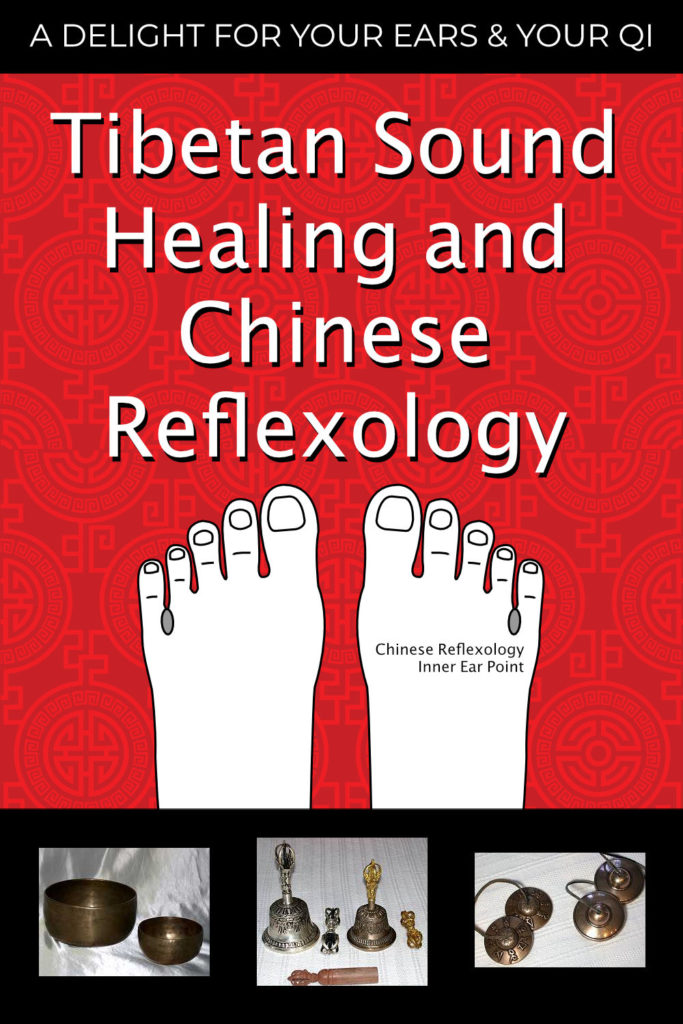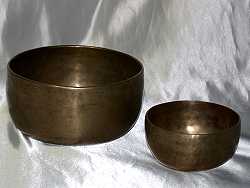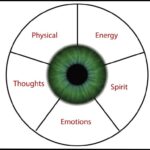Recently, my students and I were blessed with a sound healing workshop taught by Diáne Mandle. Diáne is one of the leading experts in North America on Tibetan Sound Healing. She introduced us to this healing art and treated us to a mini concert in the Sole Circle, my Chinese Reflexology and self-care membership site.
Everyone was enthralled with the enchanting and soothing sounds of the Tibetan singing bowls and the other sacred sound instruments. The experience was magical and moving, and left us feeling peaceful and relaxed.
We learned so much about Tibetan Sound healing in the workshop, and I was amazed to discover how much Tibetan Sound Healing and Chinese Reflexology have in common.
Here are some of the similarities that really stood out for me about these ancient healing arts.
Identifying Imbalances in Your Body’s Qi (Life Force Energy)
As Diáne explained about the different instruments used in sound healing, I couldn’t help but notice how their effects on the body were very similar to the approach of Traditional Chinese healing arts such as acupuncture, Qi Gong, and of course, Chinese Reflexology.
Diáne began the workshop by introducing us to Tingshas. These instruments look like two tiny cymbals, but they’re played much differently than simply banging them together. Diáne demonstrated how they’re often used incorrectly, and then she showed us the correct way to strike the Tingshas together.
She shared that Tingshas are instruments for awakening energy. They help draw out things that we may be hiding from so that we can clear them away. That’s one of the reasons Tingshas are commonly used in house clearing ceremonies.
Tingshas are also used for diagnostic purposes where Diáne listens to the sound vibrations to hear what’s going on in a person’s body. She uses the Tingshas to scan the body. She listens for differences in sound that alert her to areas that need support.
This reminded me a lot of Chinese Reflexology where I use a reflexology stick as my tool for “scanning” the reflexology points on the feet. Instead of listening to sound vibrations, I hear a person’s feet talking to me! By feeling the feet, I can learn what’s going on in a person’s body.
Moving Energy in the Body
After the Tingshas, Diáne showed us the Ganta and Dorje. The Ganta is a bell-shaped instrument that represents divine feminine energy. The Dorje looks like a two-headed scepter, and it represents divine masculine energy. You could say that the Dorje is the yang to the yin of the Ganta.
In a sound healing session, the Dorje assists with moving energy in the body. It sets the intention for movement, and the sound from the Ganta is what actually moves the energy.
Rather than simply ringing the Ganta like a dinner bell, Diáne explained that there are different “voices” based on how you use the instrument, and she follows sacred geometry patterns when moving the instrument because this helps move energy in the body.
For me, this struck a similar chord (bad pun intended) to Chinese Reflexology where stimulating foot reflexology points with a reflexology stick (my “instrument” of choice) helps to move qi in the body. When there are blocks in the flow of qi, it’s necessary to clear the blocks to help restore balance.
Aligning Energy in the Body
The last sacred instrument that Diáne introduced to us was the Tibetan singing bowl. When you think of Tibetan sound healing, these are the iconic instruments that come to mind.
Diáne explained that the purpose of the singing bowls is to align your energy. This is similar to the purpose of Chinese Reflexology and Traditional Chinese Medicine. According to Chinese Medicine theory, diseases in the body are due to an imbalance or misalignment in the flow of energy in the body.
In order to improve your health, you need to realign the energy in your body so that it is flowing smoothly and abundantly.
Deceptively Simple
Interestingly, not all Tibetan singing bowls are created equal. While you can find “singing bowls” available for sale online, and you’ll often spot bowls in many zen-inspired fitness studios, the healing properties are not the same as the traditional singing bowls.
Diáne shared that traditional Tibetan singing bowls are made from seven different types of metals, including gold, silver, tin, mercury, lead, iron, and copper. And not just any iron is used. It has to be “sky metal,” which comes from meteorites. Without all seven of these metals, the bowls are missing important harmonics for the alignment of energy.
The harmonics range from low to high frequencies, and together, they form the voice of the bowl. By listening to the bowl’s voice, Diáne is able to discern where energy is weak in a person’s body. For example, if she places a bowl on a client and doesn’t hear the highest harmonic, it can indicate potential issues in the openness of the client’s heart energy.
This got me thinking about how there are also subtle differences in people’s reflexology points that I “listen” for. Sensitivity is a big factor, but there are many other nuances. As you gain experience with Chinese Reflexology, you begin to distinguish different “feels” to the reflexology points on the feet.
For example, a health issue that is categorized as an excess pattern in Traditional Chinese Medicine will feel like a bubble in the corresponding reflexology point. On the other hand, chronic issues related to an insufficient flow of qi will often feel like tiny grains of sand in the feet.
When Diáne and I initially met to discuss the sound healing workshop for the Sole Circle, she said that one of the reasons that she started teaching sound healing was because she saw a lot of pseudo-sound healing in Western culture. It was lacking the true essence of this healing art.
During the live class, Diáne remarked,
“An orangutan can take a mallet and can be trained to play a bunch of bowls in a pattern. The healing happens when you know what you’re doing. And to really know what you’re doing, you need to be educated.”
Having a bowl and using it for a little bit of relaxation is wonderful, but don’t think that having this bowl is going to heal you unless you have a sense of things—and you especially need to be educated to do no harm. There are a lot of principles (involved) working with these instruments.”
Her comments sounded (ooh, couldn’t resist another pun here) very similar to Chinese Reflexology. Over the past couple of decades, I’ve noticed that a lot of $20 foot massage parlors have sprung up all over North America.
Yes, it might be relaxing to get your foot massaged for $20, but most of these places are lacking the healing essence of Traditional Chinese Medicine theory.
It seems so simple to poke your feet with a stick, or to randomly press on points on your feet. But just like with Tibetan Sound Healing, it’s much deeper than what you see. In Chinese Reflexology, how you massage the reflexology points and why you massage the points is at the core of the healing.
That’s why I teach how to use a Chinese Reflexology stick in a six-month in-depth program. It’s necessary to delve deeper to use the stick correctly. The stick is so powerful that there is the potential to do harm if the stick is misused.
Admittedly, before Diáne’s class, I had seen singing bowls for sale and thought to myself, Hey, it might be nice to pick up a bowl. How can simply striking a bowl with a mallet be harmful?
Now I know what I didn’t know before, and I have a much deeper appreciation and understanding of the complexity of Tibetan Sound Healing.
Beautiful Sounds
While I can write about the instruments and the sound healing experience in this article, nothing compares to actually hearing the beautiful, harmonious, and soothing sounds of the instruments being played.
You can find high-quality recordings of Diáne’s sound healing concerts available on her website. Here’s a sample from one of her concerts on YouTube. Check out the video below:
To share the authentic methods of Tibetan Sound Healing, Diáne founded the Tibetan Bowl Sound Healing School, and has written a book, Ancient Sounds for a New Age. She also offers distance sound healing sessions.
Learn more about Diáne, book a sound healing session, and find her book and recordings on her website at www.soundenergyhealing.com.







